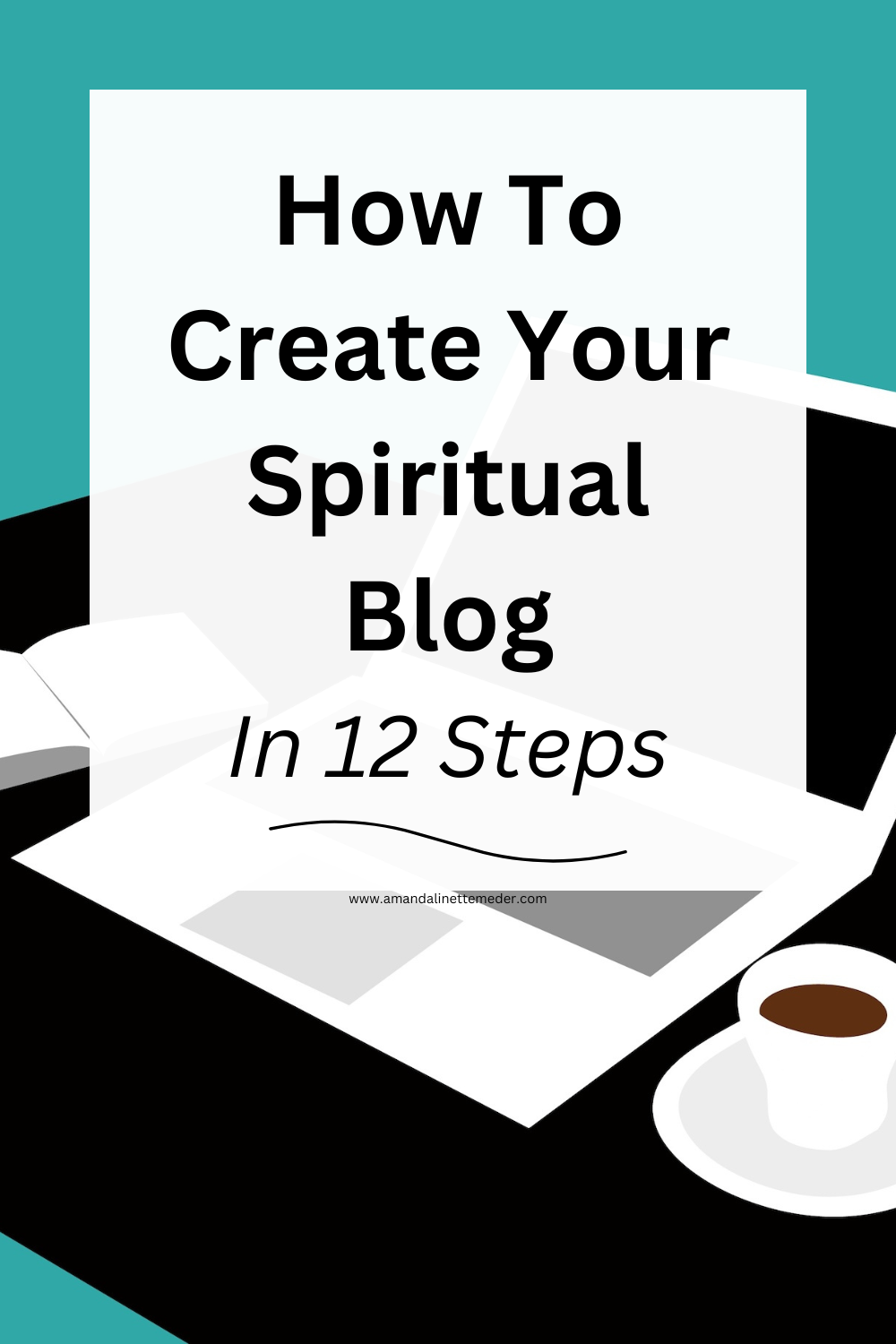How To Create Your Spiritual Blog In 12 Steps
Updated 2024.11.21. This post contains affiliate links. If you make a purchase, Amanda Linette Meder and her partners may earn a commission or other compensation, at no extra cost to you.
Back in 2013, I created this spiritual blog as a way to share what I was learning on my spiritual journey with others.
I began giving psychic and mediumship readings after taking psychic development classes that ended with me having to provide volunteer readings as practice.
I did really well in those practice readings and impressed myself. As a result, I decided to offer 100 readings to volunteers so I could “test” whether my gifts were real, and prove my gifts to myself.
Those first 100 readings were enlightening and eye opening, and following them, this blog began, as a way to both share what I learned with others, and to help other people who had gifts like me understand them.
With the publication of this blog, this spiritual blog has reached a milestone: 1,000 blogs published. It has also remained in consistent publication for over a decade and served more than 26 million readers.
I’ve also launched a website publishing business, Primal Language Productions. Through it, I teach others how to develop their website-based businesses and I’ve developed several web properties.
Today I’d like to share a bit about what I learned on the journey.
Below are 12 steps to starting a spiritual blog:
1 - Choose Your Webhost
2 - Choose a Domain Name
Think of a name for your blog. Research whether the name of the blog has been taken on WHOIS.com website registry, your local business registry and web search.
When you have a name that fits and it is not taken by anyone else (untaken names are still out there) purchase the domain name with the security add-on, since domain names are public.
Most domain name sellers have an option where you can mask your personal information, and only the domain name provider’s name and contact information will be publicly listed instead for an extra fee. I highly recommend this security upgrade.
3 - Begin Building Your Website
To start, you will need a minimum of 4 pages:
About Page
Contact Page
Privacy Policy Page
Blog Page
Begin writing the copy and fill out these pages using your own words and royalty-free photos.
4 - Add A Contact Email
You need a way for website support, readers and potential collaborators to reach you.
You can choose a paid email, where the email looks like “yourcontactalias@yourwebsite.com” or you can choose a free email, where the email looks like “yourwebsitename@gmail.com.”
It’s up to you and I’ve done it both ways.
If you want to keep it “start-up lean” right now, go with a free email and you can upgrade later when money allows.
5 - Connect to Measurement Tools
Add Google Analytics and Google Search Console tracking tags to the back of your website for Google Analytics and Google Search Console.
These two measurement tools provide you with valuable, first-party data including the search queries used to find your site, your most popular posts and the ability to submit new blogs for indexing to Google, more quickly.
6 - Add Blog Content
Begin filling your website with new and original blogs.
As you go, backlink reliable sources in your blog with hyperlinks; this starts building your website’s connection to the world wide web. Also, outbound links act as indexing cues telling website crawlers about related content to your content, which can increase your website getting indexed properly.
How many blogs does your blog need?
There is no maximum number, but there is a minimum. As a bare minimum, about 9 blogs give the website an identity and 30 blogs give you enough content to apply for advertising sponsors through Google Adsense.
Continue to add blog content until you reach around 200 posts, then use your top content as a guide for where to go next. Keep going indefinitely.
The more blogs you have, the more traffic you’ll receive, and ultimately, the more money you could make.
After developing 5 of my own blogs to date, I can confidently report it is unlikely you’ll see much traffic until you publish anywhere between 30-100 blogs, some websites require more due to higher competition in that niche.
To find spiritual content ideas, pay attention to meeting existing demand: notice what your audience asks for in their queries and use a trend search tool, like trends.google.com.
7 - Create A Social Media Presence for Your Blog
Social media helps build your backlinks, which increase your pagerank. The higher your pagerank, the more likely your website will be shared with potential new readers.
Start with three different social media pages of your choice, though I highly recommend at least one of them is Pinterest. Pinterest is a great traffic source for any website.
Post your new content on these platforms. Over time, you are likely to notice one platform where your content does really well - invest in your social media strategy there.
8 - Being Monetizing Your Work
Writers deserve to be paid for the contribution to happiness, the arts and our collective cultural evolution. You’re a writer and advertising agencies are willing to pay you.
You can make money from a spiritual blog and one of my favorite revenue streams is advertising. With advertising, you can be paid while you sleep and people continue to read your material around the world.
There are three blog advertisers I like:
Google Adsense - it is the easiest to get into and pays the least, but you can be approved when your website is as young as 3 months old with 30 or so blogs on it.
You can be paid out in $100 thresholds with a 30 day delay. In my eyes, it’s better to be paid in dollars, quarters, dimes and pennies than nothing, because it all adds up over the course of a month, quarter or fiscal year.
Monumetric - they require a minimum of 10,000 readers and it takes around 5 months to be approved, with a 3 month payment delay.
Once you’re approved, their publisher support is awesome. They can customize the way your ads display with personally tailored coding. They are the only advertiser that has sent me physical gifts in the mail, plus direct deposits.
Their onboarding process is easy, and once you’re in their system their publisher education system is unmatched - webinars, blogs, podcasts - the information I’ve learned has forever shaped how I blog.
9 - Add Affiliate Revenue
Affiliate income is another source of revenue that pays.
The easiest affiliate program to get started with is Amazon Associates. You simply head to Amazon Associates, create an account and the gears will start turning from there.
10 - Add Your Own Services and Products
Now that you have set your blog up with an array of quality blogs, advertising and affiliate revenue, it’s time to add your own services for sale.
To decide what services and products to offer, evaluate your niche’s interests and needs.
Revisit your top blogs: is there an eBook or eCourse that you could expand on here?
Evaluate industry holes: have you noticed any gaps in the industry? Is there something you wished was offered but isn’t?
Client requests: have customers asked you to offer something specific? Can you bundle it up and sell it?
11 - Add a Newsletter List
You can begin collecting names and email addresses before you send your first email. To get interested fans on your newsletter list, consider offering a gift for subscribers - like a deep-dive eGuide, a special guided meditation or a discount code, if you’re already selling products.
12 - Maintain Your Blog
You are now a webmaster. You own a part of internet real estate, that’s exciting and something to be proud of.
You will have to become familiar with web speak like HTML, Javascript and CSS, so you may want to check out a few books on these topics from the library.
As a website owner, you will have to regularly maintain your website.
Regular website maintenance includes repairing broken or dead links, refreshing your promotional/seasonal content, rerouting web pages when promotional campaigns or old links are discontinued, updating the design to keep it looking fresh, refreshing top performers with the latest and more.
Develop regular website maintenance standard operating procedures (SOPs) to use both monthly and annually. Keep them up to date with your current processes every time you use them.
After you have done all of the above, continue to add blogs, affiliate links and products, evaluating with your selected success metrics as you go.
When you notice something working, dive in there.
For more on this topic:
Check out The Grow Your Intuitive Business eCourse or the Business Center in The Membership, a portal with exclusive content for growing your digital spiritual business! If you would like me to evaluate your blog or provide you with a personalized plan to grow your web based spiritual business, please contact me for private business coaching.
As a Squarespace, Mediavine and Flodesk Affiliate, this site earns income through qualifying purchases made through affiliate links in this post.




